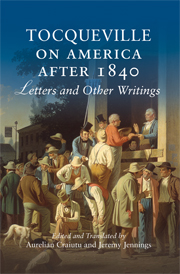Book contents
- Frontmatter
- Contents
- Editors' Note and Acknowledgments
- Interpretative Essay: The Third Democracy: Tocqueville's Views of America after 1840
- PART I LETTERS
- Introduction
- A Letters: 1840–1847
- B Letters: 1848–1852
- C Letters: 1853–1856
- D Letters: 1857–1859
- Undated and Partially Dated Letters
- E Letters between Tocqueville and His French and Other Correspondents
- PART II SPEECHES, ARTICLES, AND DIPLOMATIC PAPERS
- Appendix 1 Tocqueville's American Correspondents
- Appendix 2 Chronology
- Appendix 3 Sources for the Texts and Selected Bibliography
- Notes
- Index
E - Letters between Tocqueville and His French and Other Correspondents
Published online by Cambridge University Press: 05 June 2012
- Frontmatter
- Contents
- Editors' Note and Acknowledgments
- Interpretative Essay: The Third Democracy: Tocqueville's Views of America after 1840
- PART I LETTERS
- Introduction
- A Letters: 1840–1847
- B Letters: 1848–1852
- C Letters: 1853–1856
- D Letters: 1857–1859
- Undated and Partially Dated Letters
- E Letters between Tocqueville and His French and Other Correspondents
- PART II SPEECHES, ARTICLES, AND DIPLOMATIC PAPERS
- Appendix 1 Tocqueville's American Correspondents
- Appendix 2 Chronology
- Appendix 3 Sources for the Texts and Selected Bibliography
- Notes
- Index
Summary
Introduction
The letters selected in this section cover the period 1847 to 1857 and were exchanged between Tocqueville and some of his closest friends such as Gustave de Beaumont, Louis de Kergorlay, Jean-Jacques Ampère, Arthur de Gobineau (author of the controversial Essai sur l'inégalité des races humaines), Nassau Senior (a well-known nineteenth-century British economist), and the Count and Countess de Circourt. Throughout the 1850s, Tocqueville attended the salon hosted by the Countess de Circourt and he exchanged a lengthy correspondence with the Count de Circourt, mostly concerning diplomatic affairs.
The selections from the letters included in this section touch upon many of the themes to be found in the correspondence between Tocqueville and his American friends and acquaintances after 1840. In his letters to Beaumont, for example, Tocqueville's worries about his investments in America loomed large and he also made references to the immigration of large numbers of Germans who arrived in American without any knowledge or familiarity with the traditions of liberty and self-government. The letters received from Adolphe de Circourt – for the most part written against the backdrop of the Crimean War that had brought England and France into conflict with Russia – confirmed Tocqueville's growing sense that, as the 1850s progressed, the United States was increasingly acting as an expansionist power, ready to intervene in the affairs of the old world and often in a reckless manner.
- Type
- Chapter
- Information
- Tocqueville on America after 1840Letters and Other Writings, pp. 318 - 340Publisher: Cambridge University PressPrint publication year: 2009



